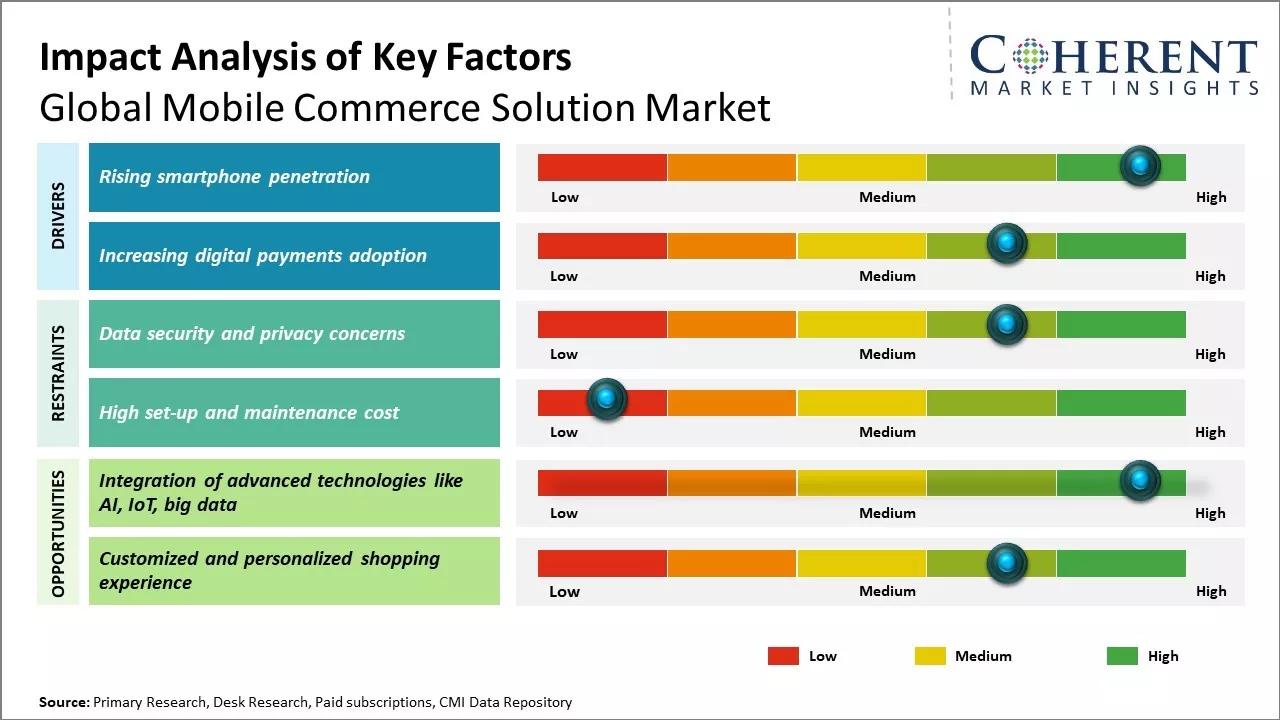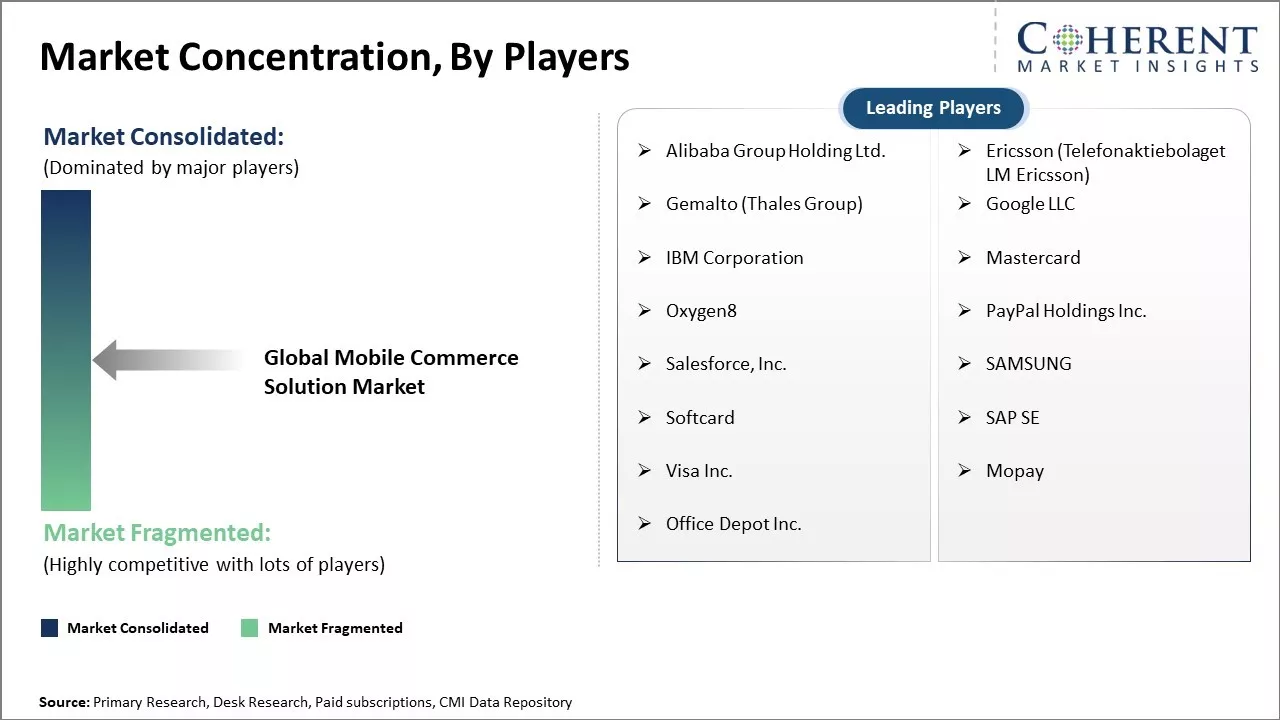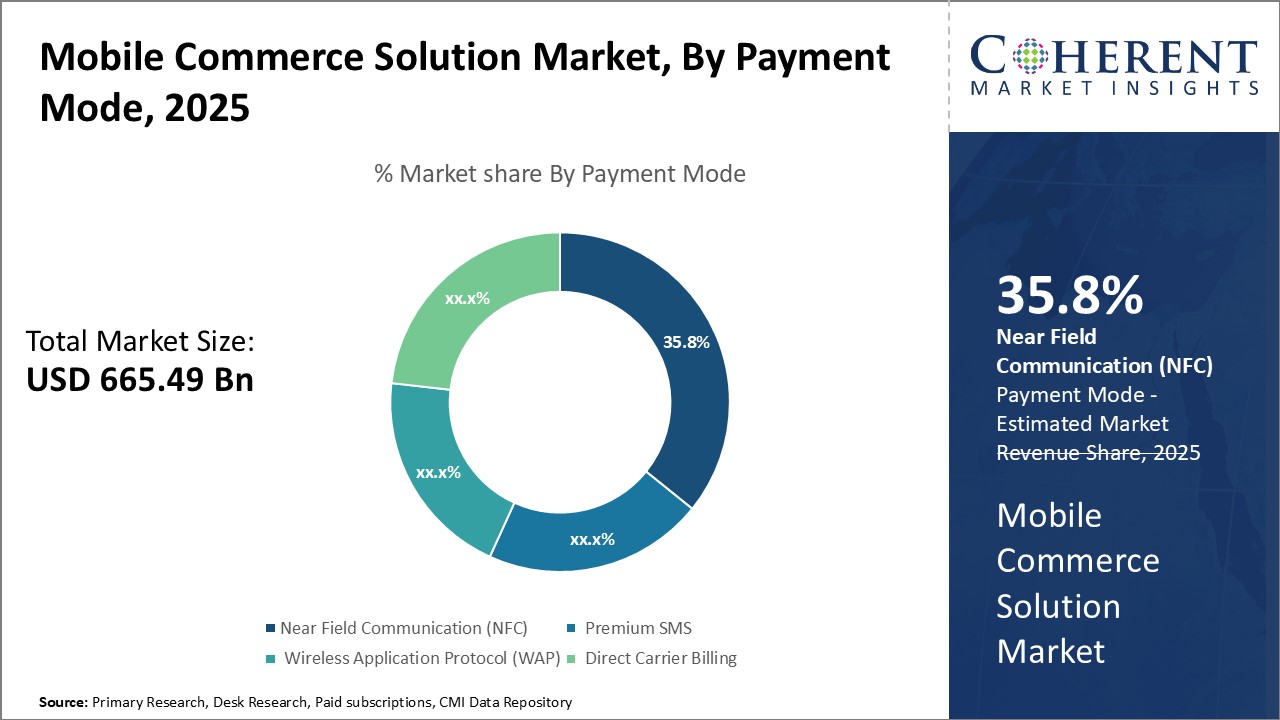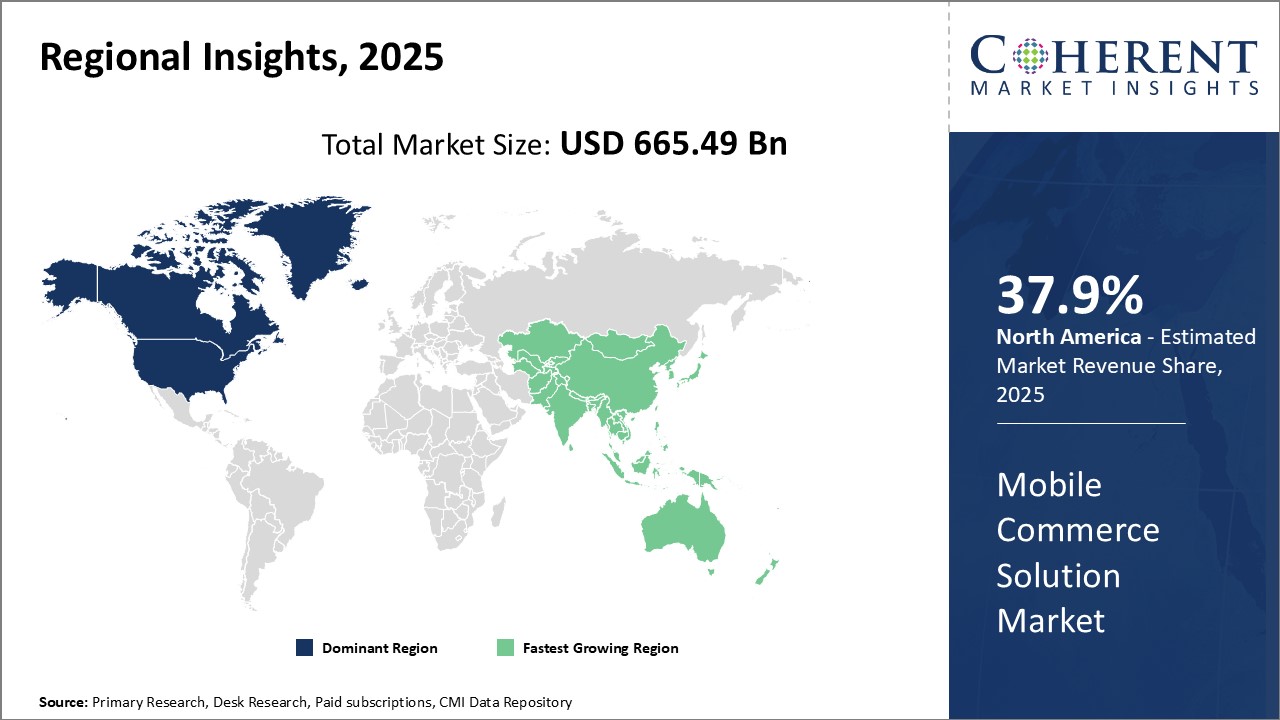Mobile Commerce Solution Market Size and Trends
The Global Mobile Commerce Solution Market is estimated to be valued at US$ 665.49 Bn in 2025 and is expected to reach US$ 3,104.65 Bn by 2032, exhibiting a compound annual growth rate (CAGR) of 24.6% from 2025 to 2032.

Discover market dynamics shaping the industry: Download Free Sample
The growing adoption of smartphones and increasing penetration of internet across the world are driving the demand for mobile commerce solutions. Various factors such as rising mobile transactions, increasing m-commerce sales, and growing investments by solution providers are expected to provide opportunities for market growth. Moreover, transition to 5G networks and integration of advanced technologies like AI and Machine Learning in mobile commerce solutions are anticipated to fuel the market expansion. However, data privacy and security concerns related to financial transactions through mobile devices may hamper the growth of the mobile commerce solution market.
Drivers of the Market:
Rising smartphone penetration
The global proliferation of smartphones in recent years has been unprecedented. What was once viewed as a luxury item limited to developed markets has now become ubiquitous even in developing markets. Lower upfront device prices coupled with affordable data plans have brought internet-enabled smartphones within the reach of billions more consumers around the world. The massive and ever-increasing base of internet-connected individuals carries immense potential for m-commerce. Smartphone owners have grown accustomed to conducting various activities like social networking, content consumption, navigation, and more on their mobile devices. It was only natural that digital payments and online shopping also shifted to mobile platforms. The always-connected nature of smartphones allows consumers to make purchases anytime, anywhere without needing to sit in front of a computer or visit physical stores. This has spawned a new paradigm of buying behaviors centered on convenience, impulse purchases, and instant gratification, all of which drive greater m-commerce activities.
Market Concentration and Competitive Landscape

Get actionable strategies to beat competition: Download Free Sample
Increasing digital payments adoption
Digital and contactless payment systems have proliferated rapidly in tandem with the smartphone and internet revolution. Various payment options from digital wallets and peer-to-peer transfer apps to NFC-enabled card payments have emerged as convenient alternatives to cash. The ongoing coronavirus pandemic has further accelerated the migration from cash to digital payments due to hygiene concerns. Consumers have realized the ease, security, and other benefits of making digital payments for both in-store as well as online transactions using their smartphones. Digital payment gateways have also made the online checkout experience seamless by auto-filling billing details and enabling one-click payments. This has removed a potential barrier for m-commerce growth. Additionally, businesses are integrating digital payment acceptance capabilities to provide a superior Omni channel shopping experience and attract more customers. As digital payments become increasingly mainstream in everyday life, more and more purchase occasions will shift to mobile commerce platforms going forward. Overall, the rising adoption of digital money should act as a significant driver of the global mobile commerce solutions demand.
Key Takeaways from Analyst:
The increasing adoption of m-commerce apps by retailers and merchants. More businesses are developing dedicated mobile shopping apps and optimizing their websites for smaller screens to provide an enhanced user experience to customers on the go. This is enabling wider product discovery and impulse buying via smartphones.
Transition to cashless payments has also facilitated the rise of mobile commerce. The availability of digital payment options like mobile wallets, UPI, and digital credit/debit cards has simplified the payment process for consumers on mobile platforms. This acts as a restraint remover for m-commerce growth.
The Asia Pacific region is projected to dominate the global mobile commerce solution market in the coming years. This can be attributed to the large populations in these region that are very receptive to new technologies. Their growing middle-class continues to adopt smartphones at a rapid pace, shifting more purchases online through mobile platforms.
Market Challenges: Data security and privacy concerns
Data security and privacy concerns are a major restraint on the growth of the global mobile commerce solution market. As online shopping and digital payments increase through mobile platforms, customers have growing worries about how their personal and financial data is being protected. Numerous data breaches and privacy scandals in recent years have eroded consumer trust in the ability of tech companies to keep their data safe.
This lack of trust has a direct impact on companies' abilities to expand their mobile user base and increase engagement with their platforms. Customers who are worried about cyber threats may avoid using apps for banking, shopping, or other activities if proper safeguards are not in place. They could opt to stick with traditional in-store purchases or website-based options rather than taking their business to the convenience of mobile formats. The insufficient prioritization of privacy and security also presents a barrier for businesses to enter new international markets, as regulators in other countries may impose stringent data protection laws that companies are not equipped to meet.
Perhaps most importantly, security and privacy issues create uncertainty that slows the rate of technological advances supporting mobile commerce. Innovations in areas like AI, cloud computing, biometrics and cashless payments could accelerate the transition to an entirely digital marketplace. However, developers may hesitate to fully explore new frontiers if each brings higher risks of exposing sensitive user data. Addressing longstanding vulnerabilities and building confidence in data governance should be a priority if the industry wishes to unleash the full potential of emerging mobile business models.
Market Opportunities: Integration of advanced technologies like AI, IoT, big data
The integration of advanced technologies such as artificial intelligence, internet of things and big data offers tremendous opportunities for growth in the global mobile commerce solution market. These technologies allow for more personalized, predictive and data-driven customer experiences.
AI and machine learning algorithms can analyze vast amounts of customer transaction and behavioral data to better understand purchase patterns and preferences. This personalized data can then be used to deliver highly tailored recommendations, notifications and product suggestions directly to customers on their mobile devices. For example, AI can detect if a customer routinely purchases certain items together and automatically suggest adding those complementary items to their cart. It can also identify routine replenishment needs for consumable products. This elevated level of convenience and relevant suggestions keeps customers engaged with mobile commerce platforms and encourages repeat purchases.
IoT connectivity between customer devices, products and supply chain systems enables an even more seamless integration between the digital and physical worlds. Smart home appliances and connected devices can auto-replenish essential goods based on real-time usage data without any manual reordering from the customer. Pharmacies can provide automatic prescription refill reminders and processing. Such a frictionless experience saves customers’ time while ensuring their needs are continuously met.

Discover high revenue pocket segments and roadmap to it: Download Free Sample
Insights By Payment Mode - Convenience and Security Drive NFC Adoption in Mobile Payments
In terms of payment mode, the near field communication (NFC) segment is expected to hold 35.8% share of the global mobile commerce solution market in 2025 owing to its convenience and security. NFC allows for simple contactless transactions between smartphones and point-of-sale terminals with just a tap. This frictionless checkout experience removes the hassle of exchanging cash, credit cards, or signing receipts. The extreme ease of NFC payments has made it the preferred option for many quick retail purchases and transit fare payments.
Its proximity-based authentication also gives customers peace of mind. NFC uses encrypted communication over short ranges, so there is no risk of data being intercepted during transmission as can happen with wireless technologies. Customers feel safe knowing their financial details remain tightly protected within the NFC chip of their phone. This security has helped convince many users who were previously hesitant about mobile payments.
Major Smartphone manufacturers have rushed to include NFC chips as a standard feature, expanding the pool of available NFC-enabled devices. Additionally, major mobile operating systems have also built-in support for NFC, making it simple for developers to integrate payments into their apps. Large payment networks like Visa, MasterCard, and Google Pay have also driven adoption by bringing their brands and large customer bases to NFC. As infrastructure and acceptance of NFC payments continues growing, its advantage over alternatives in checkout speed and protection will ensure its position as the top payment mode in the coming years.
Insights By transaction type - M-Retailing's Personalization Drives Leading Share in Mobile Commerce Transactions
In terms of transaction type, the m-retailing segment is expected to hold 44.3% share to the global mobile commerce solution market in 2025 due to the personalized experience it provides. M-Retailing involves using mobile platforms such as apps or mobile websites to browse and purchase products remotely. This allows merchants to gain deep insights into customers' preferences through their digital footprints.
Analyzing online browsing behavior, past purchases, locations, and more enables companies to tailor their marketing and product recommendations much more effectively than traditional retail settings. Customers appreciate the convenience of having specially curated deals and items pushed directly to their phones. They also enjoy the social features that let them seek advice from friends or share purchases, creating a sense of community.
Major retailers have highly optimized their mobile sites and apps to offer personalized search results, instant checkout with saved profiles, loyalty programs, reviews, and engaging content to inspire further spending. Customers now regularly use their phones to comparison shop and purchase anything from clothing to electronics to groceries. As mobile density and data speeds continue rising globally, M-Retailing allows companies to utilize every digital interaction as an opportunity to strengthen customer relationships, driving its leadership in the transaction type segment.
Regional Insights

Need a Different Region or Segment? Download Free Sample
North America has emerged as the dominant region in the global mobile commerce solution market. The region is expected to account for 37.9% of the market share in 2025. This can be attributed to high adoption of smartphones and presence of key technology players in countries like the U.S.. The large tech companies based in the U.S. are investing heavily in developing advanced mobile payment technologies which can provide seamless shopping experiences. Moreover, there is a rising trend of contactless payments through mobile devices which has boosted growth of third-party payment platforms in the region. Several small as well as large retailers have incorporated mobile payment options at point-of-sale to give customers flexibility and convenience in transactions.
The Asia Pacific region is seeing fast growth in the mobile commerce solution market, fueled predominantly by China and India. In these populous nations, there is a huge young consumer base which is very open to new technologies. The improving digital and internet infrastructure has enabled the high adoption of e-commerce and online shopping habits. Additionally, these developing economies have seen rising disposable incomes which have boosted discretionary spending on consumer goods through mobile devices. Local technology companies as well as global players are focusing on these emerging markets and have launched affordable payment services tailored for these price-sensitive consumers. This strong growth momentum is expected to continue as technology penetration increases further in Asia Pacific.
Market Report Scope
Mobile Commerce Solution Market Report Coverage
| Report Coverage | Details | ||
|---|---|---|---|
| Base Year: | 2024 | Market Size in 2025: | USD 665.49 Bn |
| Historical Data for: | 2020 To 2024 | Forecast Period: | 2025 To 2032 |
| Forecast Period 2025 to 2032 CAGR: | 24.6% | 2032 Value Projection: | USD 3,104.65 Bn |
| Geographies covered: |
|
||
| Segments covered: |
|
||
| Companies covered: |
Alibaba Group Holding Ltd., Ericsson (Telefonaktiebolaget LM Ericsson), Gemalto (Thales Group), Google LLC, IBM Corporation, Mastercard, Oxygen8, PayPal Holdings Inc., Salesforce, Inc., SAMSUNG, Softcard, SAP SE, Visa Inc., Mopay, and Office Depot Inc. |
||
| Growth Drivers: |
|
||
| Restraints & Challenges: |
|
||
Uncover macros and micros vetted on 75+ parameters: Get instant access to report
Mobile Commerce Solution Industry News
In October 2023, Global Payments, a leading provider of payment technology and software solutions, collaborated with Visa, a global leader in digital payments, to launch the Mobile Tap payment solution in Singapore. This innovation aims to transform the payment ecosystem by enabling merchants to process payments directly through their smartphones, thereby eliminating the need for additional hardware investments.
In March 2023, Amazon.com, Inc., a leading e-commerce company, announced the launch of 3-Way Match on the Amazon Business mobile app to assist business customers in improving and enhancing their smart business-buying strategies and automating reporting.
In September 2023, Ericsson, a leading provider of telecommunications equipment and services, announced its partnership with Deutsche Telekom (DT), a major Germany-based telecommunications company, to launch a commercial partnership and offer communication and network APIs to developers and enterprises.
*Definition: The Global Mobile Commerce Solution Market provides mobile commerce platforms and solutions that enable businesses to engage customers, drive online sales and optimize the mobile shopping experience. It offers technologies like responsive mobile websites, mobile applications, mobile marketing platforms and services that allow businesses to set up an effective online and mobile presence. The solutions help companies reach mobile users, increase conversions, enhance customer experience and grow mobile sales on a global scale.
Market Segmentation
- Payment Mode Insights (Revenue, US$ Bn, 2020 - 2032)
- Near Field Communication (NFC)
- Premium SMS
- Wireless Application Protocol (WAP)
- Direct Carrier Billing
- Transaction Type Insights (Revenue, US$ Bn, 2020 - 2032)
- M-Retailing
- M-Ticketing/Booking
- M-Billing
- Others
- Regional Insights (Revenue, US$ Bn, 2020 - 2032)
- North America
- U.S.
- Canada
- Latin America
- Brazil
- Argentina
- Mexico
- Rest of Latin America
- Europe
- Germany
- U.K.
- Spain
- France
- Italy
- Russia
- Rest of Europe
- Asia Pacific
- China
- India
- Japan
- Australia
- South Korea
- ASEAN
- Rest of Asia Pacific
- Middle East & Africa
- GCC Countries
- Israel
- South Africa
- Rest of Middle East & Africa
- North America
- Key Players Insights
- Alibaba Group Holding Ltd.
- Ericsson (Telefonaktiebolaget LM Ericsson)
- Gemalto (Thales Group)
- Google LLC
- IBM Corporation
- Mastercard
- Oxygen8
- PayPal Holdings Inc.
- Salesforce, Inc.
- SAMSUNG
- Softcard
- SAP SE
- Visa Inc.
- Mopay
- Office Depot Inc.
Share
Share
About Author
Suraj Bhanudas Jagtap is a seasoned Senior Management Consultant with over 7 years of experience. He has served Fortune 500 companies and startups, helping clients with cross broader expansion and market entry access strategies. He has played significant role in offering strategic viewpoints and actionable insights for various client’s projects including demand analysis, and competitive analysis, identifying right channel partner among others.
Missing comfort of reading report in your local language? Find your preferred language :
Transform your Strategy with Exclusive Trending Reports :
Frequently Asked Questions
EXISTING CLIENTELE
Joining thousands of companies around the world committed to making the Excellent Business Solutions.
View All Our Clients
